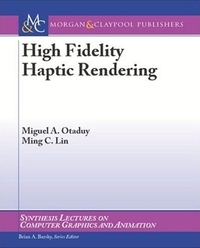High Fidelity Haptic Rendering
暫譯: 高保真觸覺渲染
Lin/Otaduy
- 出版商: Morgan & Claypool
- 出版日期: 2006-11-07
- 售價: $1,830
- 貴賓價: 9.5 折 $1,739
- 語言: 英文
- 頁數: 112
- ISBN: 1598294083
- ISBN-13: 9781598294088
-
相關分類:
數位影像處理 Digital-image
海外代購書籍(需單獨結帳)
商品描述
Description
The human haptic system, among all senses, provides unique and bidirectional communication between humans and their physical environment. Yet, to date, most human-computer interactive systems have focused primarily on the graphical rendering of visual information and, to a lesser extent, on the display of auditory information. Extending the frontier of visual computing, haptic interfaces, or force feedback devices, have the potential to increase the quality of human-computer interaction by accommodating the sense of touch. They provide an attractive augmentation to visual display and enhance the level of understanding of complex data sets. They have been effectively used for a number of applications including molecular docking, manipulation of nano-materials, surgical training, virtual prototyping, and digital sculpting. Compared with visual and auditory display, haptic rendering has extremely demanding computational requirements. In order to maintain a stable system while displaying smooth and realistic forces and torques, high haptic update rates in the range of 5001000 Hz or more are typically used. Haptics present many new challenges to researchers and developers in computer graphics and interactive techniques. Some of the critical issues include the development of novel data structures to encode shape and material properties, as well as new techniques for geometry processing, data analysis, physical modeling, and haptic visualization.
This synthesis examines some of the latest developments on haptic rendering, while looking forward to exciting future research in this area. It presents novel haptic rendering algorithms that take advantage of the human haptic sensory modality. Specifically it discusses different rendering techniques for various geometric representations (e.g. point-based, polygonal, multiresolution, distance fields, etc), as well as textured surfaces.
It also shows how psychophysics of touch can provide the foundational design guidelines for developing perceptually driven force models and concludes with possible applications and issues to consider in future algorithmic design, validating rendering techniques, and evaluating haptic interfaces.
商品描述(中文翻譯)
**描述**
人類的觸覺系統在所有感官中,提供了人類與其物理環境之間獨特且雙向的溝通。然而,迄今為止,大多數人機互動系統主要集中在視覺信息的圖形渲染上,而對聽覺信息的顯示則相對較少。擴展視覺計算的邊界,觸覺介面或力回饋裝置有潛力通過適應觸覺來提高人機互動的質量。它們為視覺顯示提供了吸引人的增強,並提高了對複雜數據集的理解水平。這些技術已被有效應用於多種應用,包括分子對接、納米材料的操作、外科訓練、虛擬原型製作和數位雕刻。與視覺和聽覺顯示相比,觸覺渲染對計算的要求極高。為了在顯示平滑且真實的力和扭矩的同時保持系統穩定,通常使用500至1000 Hz或更高的高觸覺更新率。觸覺技術為計算機圖形學和互動技術的研究人員和開發者帶來了許多新的挑戰。一些關鍵問題包括開發新型數據結構以編碼形狀和材料特性,以及幾何處理、數據分析、物理建模和觸覺可視化的新技術。
本綜述檢視了觸覺渲染的一些最新發展,同時展望該領域未來令人興奮的研究。它提出了利用人類觸覺感知模式的創新觸覺渲染算法。具體而言,它討論了針對各種幾何表示(例如基於點的、多邊形的、多解析度的、距離場等)以及紋理表面的不同渲染技術。
它還展示了觸覺心理物理學如何為開發感知驅動的力模型提供基礎設計指導,並以未來算法設計、驗證渲染技術和評估觸覺介面的可能應用和需考慮的問題作結。






























